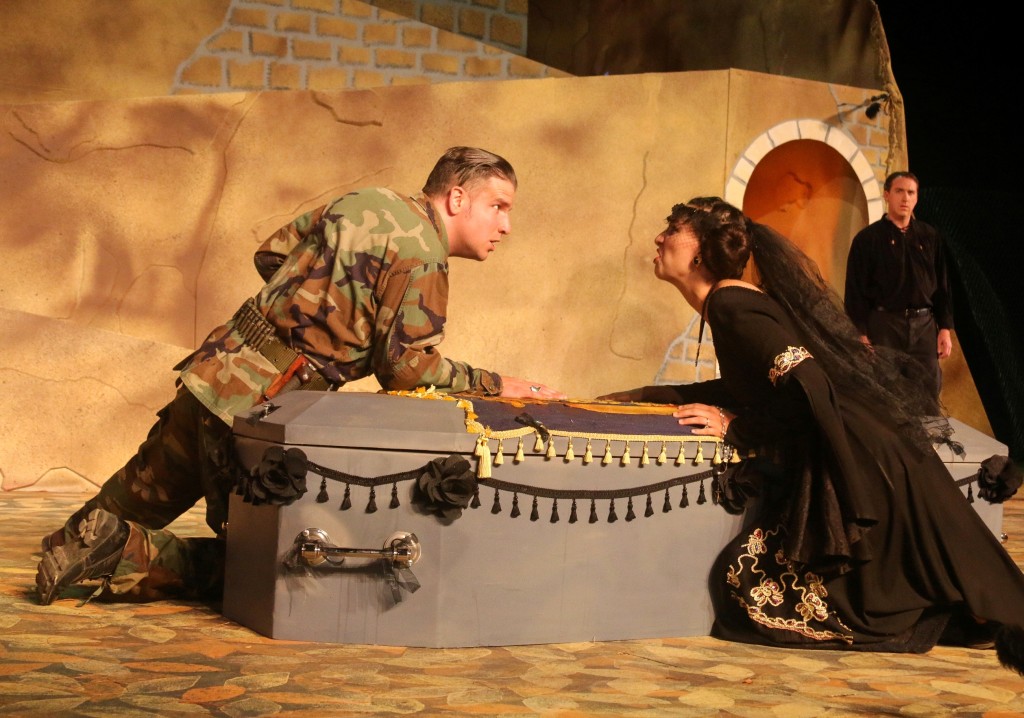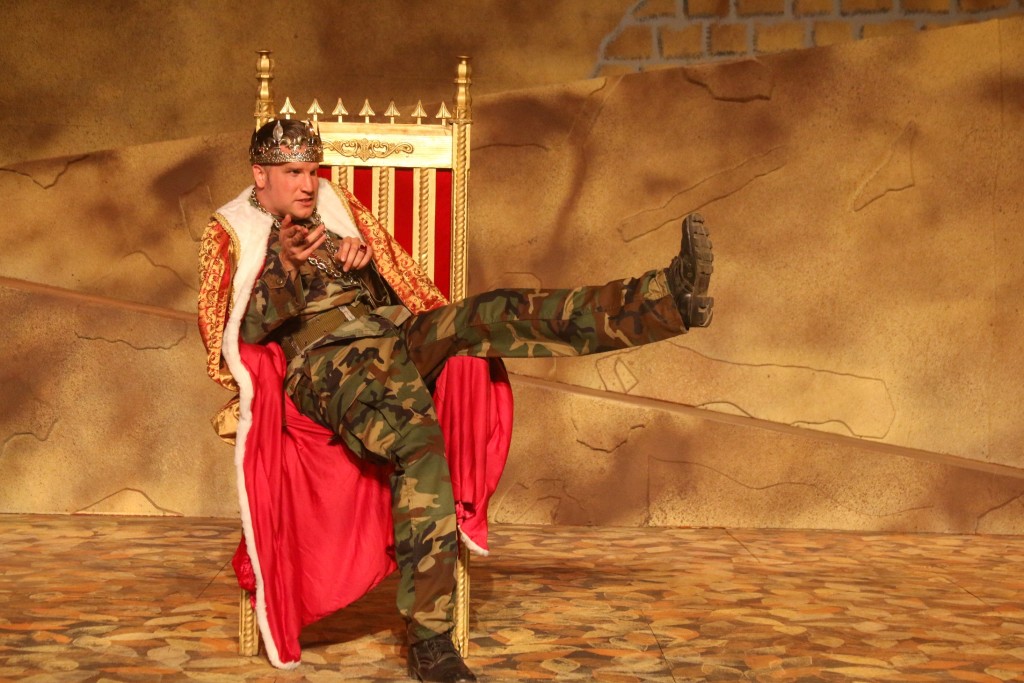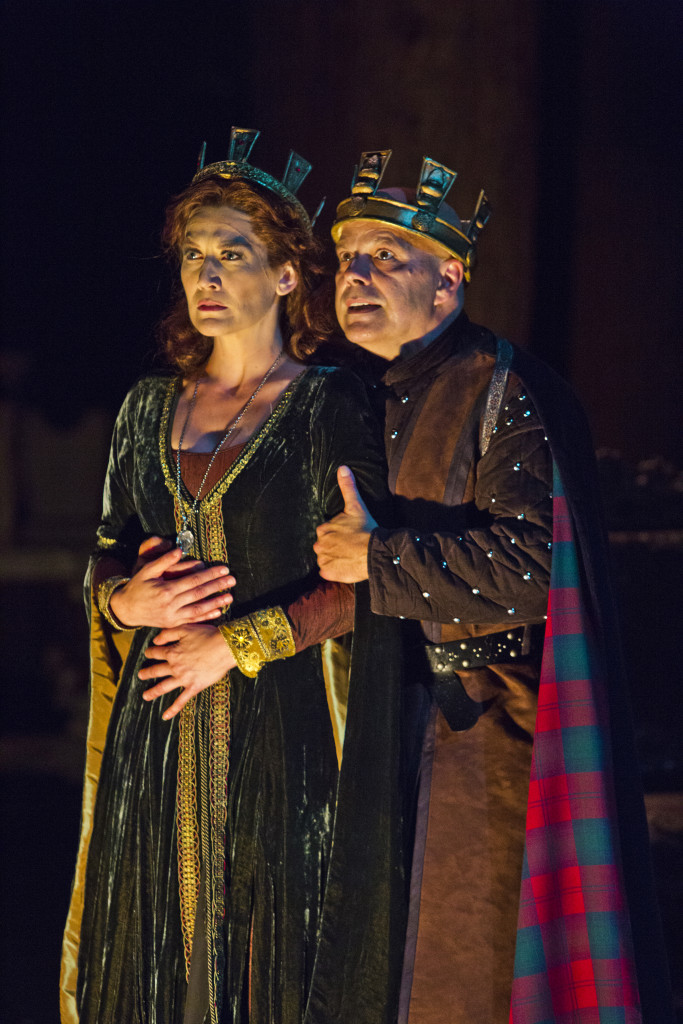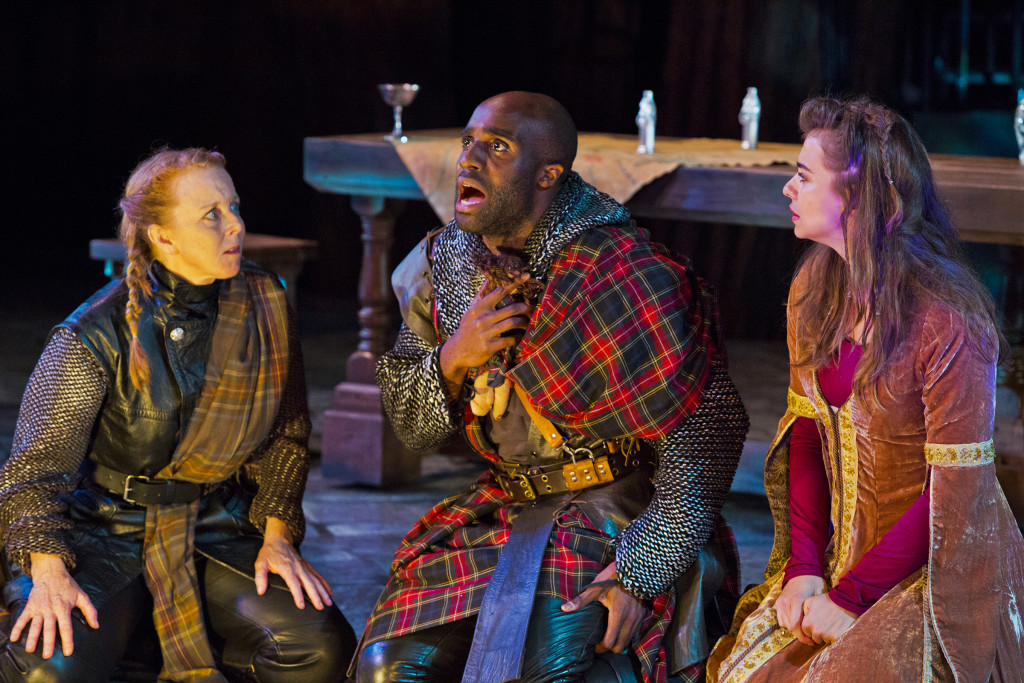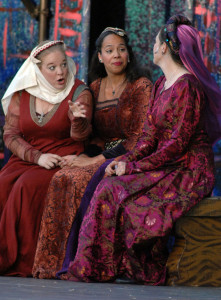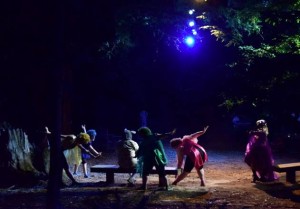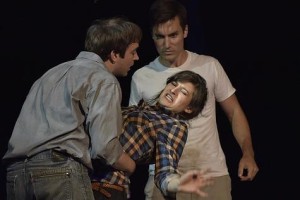Till fit time call thee to answer: A Review of OTHELLO at Marin Shakespeare Company
September 4, 2016 § Leave a Comment
That Dameion Brown turns in an impressive performance in his professional debut, and in the challenging role of Othello at Marin Shakespeare Company no less, is almost beside the point. His performance is less important than what he represents as he makes history. Brown, you see, is only a year out of prison after 23 years behind bars. His training is a result of Marin Shakes’ Arts-in-Corrections program under the direction of Managing Director Leslie Currier. His only previous experience was as Macduff in Macbeth in a production at Solano State Prison.

Dameion Brown as Othello. All photos by Steve Underwood.
“Rough” Theatre
If you knew none of that, and watched Robert Currier’s production without any context, the surface appearance was that of a fairly ordinary production of Shakespeare’s tragedy. Marin’s approach to conceptualizing and design has usually been conventional, and always a little “rough” in Peter Brook’s appreciative sense. This production is no exception. It is set in period, with fairly low-budget set and costumes; interpretively uncontroversial.
Knowing Brown’s story, however, one cannot help but view this production through the filter of one’s knowledge of our dysfunctional criminal justice system, its disproportionate effect on men-of-color, and the growing frustration (at least in liberal enclaves like the Bay Area) that unjust scapegoating has become so systemic that it may be a bigger problem than the problems corrections supposedly correct.
By making the brave decision to cast Brown, and to highlight his incarceration record rather than downplay it, the production instantly brings us into dialogue with Shakespeare in an almost visceral way. Nothing special needs to be adjusted to make clear the “othering” of Othello, the casual dismissal of everything good about him, while social prejudice insidiously makes all plots against him easily accomplished. Brown’s presence is statement enough.
It also reminds us of why drama can be so central to social discourse. Brown is, after all, an example of rehabilitation. Example shows us some paths forward that are not about locking young men-of-color up and throwing away the key. “Law and order,” so much a topic of this year’s election season, suddenly seems to be a less automatic pairing.

Dameion Brown as Othello, Cassidy Brown as Iago
Inkblots
I liked this production, without finding it revelatory about the text. (For contrast, here is a review of a production of Othello by the Arabian Shakespeare Company from 2014 of a production that I did find illuminating. By the way, ASC company has a forthcoming Macbeth that I am itching to see already.) What I think Marin does especially well, however, is have a sense of the current moment that – like a Rorschach inkblot – pulls the submerged ideas out where they can be examined. Last summer their Richard III was positively Trumpian without resorting to any obvious imitation or parody. This Othello is just as current and unnervingly relevant. That is the result of deepest values of the company, like the long-term commitment to Arts-in-Correction and the successfully empowering Brown to see his own possibility, not to pasted-on references that make it temporarily topical. They do not so much uncover new aspects of Shakespeare’s plays as simply lay them bare, in the right context and at the right time.
That is not to say that there was not was much to admire in numerous performances, in addition to Brown’s. Company stalwart Cassidy Brown, cast almost ridiculously against his usual comic type, is a fine Iago and a heroically supportive stage partner. Luisa Frasconi, despite being dressed in Renaissance costume, brings an attitudinally contemporary edge to Desdemona that fits well with the play’s context. Elena Wright, usually a leading lady, is powerful as Emilia. Currier’s staging was clean, efficient, and communicative.

Luisa Frasconi as Desdemona with Dameion Brown.
When all is said and done, however, I think that most of the audience seemed less focused on what they were seeing onstage than what they were seeing in themselves. Isn’t that what theatre is supposed to help us do?
Othello
Marin Shakespeare Company
Forest Meadows Amphitheatre at Dominican University of California
890 Belle Avenue, San Rafael, CA 94901
Aug. 26 to Sept. 25, 2016
(seen Sept. 2, 2016)
$10 to $35
Admission at the door is $35 general; $32 senior; and $10 youth (25 and under). Preview performances are $12 per person. “Pay Your Age” is offered to audience members between the ages of 26 and 34 when purchasing tickets at the Box Office on the day of any performance, with valid identification. Marin Shakespeare Company also offers those 65 and over half-price tickets at Senior Matinees and those ages 18 and under admitted free at Family Matinee performances.
http://marinshakespeare.org/tickets/ or 415-499-4488
A Woman in the Lead: A Review of HAMLET at Santa Cruz Shakespeare
August 26, 2016 § Leave a Comment
At Santa Cruz Shakespeare Kate Eastwood Norris is not only a woman playing Hamlet, she is playing Hamlet as a woman – and the result is every bit as wonderful (in an especially Santa Cruz-ish way) as you might expect.
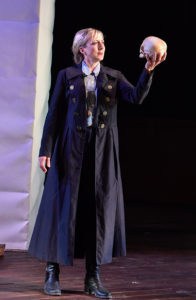
Kate Eastwood Norris (Hamlet) in Santa Cruz Shakespeare’s 2016 production of Hamlet 2016. Photo by Jana Marcus.
Although a woman playing the role of Hamlet is not nearly as rare in theatre history as most would suppose, or even unique to the San Francisco Bay Area this season (given Shotgun Players’ conceptually fascinating Hamlet roulette which randomly selects a women for the role in about half of its performances) Ms. Norris in the title role at Santa Cruz Shakespeare is notable for a number of reasons. First, she is genuinely good in the part. Second, she debuted in the part the same night that Hillary Clinton became the first woman nominee of a major party for President of the United States and the historic resonance with the audience was palpable. Most of all, however, what makes this casting particularly interesting is that it is situated within a production that genderbends a number of roles in ways that illuminate the play anew.
Gender Equity In Action
This is the second season in which Artistic Director Mike Ryan has pursued a policy of gender equity in casting. This is no mean feat, since Shakespeare’s plays do not feature anything like equal balance of male and female characters. Most companies that are trying to address this concern (not nearly enough) do so by pursuing what is known as “gender-blind” casting, wherein women are cast in male gendered parts but the convention is that the underlying gender of the actor is irrelevant and essentially ignored. Others do so by “conceptual casting,” in which women simultaneously “play” and “comment on” their characters. In this case, the female interpretation of the male role becomes the major interest. This tends to be especially true of all-female productions.
Ryan has consistently taken a different tack. At SCS, the roles have been regendered to match that of the actors playing them. In this production, not just Hamlet, but also Polonius, Rosencrantz, Guildenstern and Francisco all become female characters. (Unsurprisingly, from the point of parity, no gender bending moved characters from female to male, but – at least in the case of Ophelia – this still had interesting consequences.) Although it is the sort of change that makes purists blanch because it alters the play in some fundamental ways, it also provides new perspectives on often overly familiar literature that can (when well done) make it a totally new experience. This has become the house style at SCS concerning gender, although the company (or at least its predecessor company, Shakespeare Santa Cruz) has long practiced color-blind casting, as it does in this production.
Director Paul Mullins* handled this reframing of the play with exceptional skill and succeeds in helping us rethink this masterpiece. (His staging is beautiful, and his pacing and shaping of the performance masterful but it is his interpretive skills that set him apart here.)
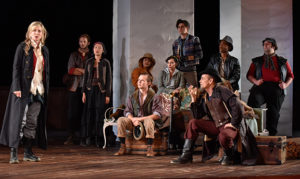
Kate Eastwood Norris (Hamlet) and Larry Paulson (Player King) and the other Players in Paul Mullins’ beautiful staging. Photo by Jana Marcus.
Visuals
Collette Pollard’s set for this outdoor venue is a large neutral space punctuated with seven tall white columns. (Kent Dorsey’s lights made little impression in the bright afternoon sun at the matinee I attended, but might be a totally different experience during evening performances.) B. Modern’s eclectic costumes feature everything from plaid-skirted schoolgirls to medieval robes, but largely settle into a vaguely Edwardian look. It is a kind of alternate Edwardian universe, however, where same-sex marriage is so routine that the possibility raises no eyebrows. Proudly liberal Santa Cruz has, apparently, always been Santa Cruz. (Except for pronouns, no lines were changed in this version to reflect the gender-bending. Even Hamlet’s extremely hetero-normative “Will thou be a breeder of sinners?” survived the editor’s red pen, although it no longer seems a logical concern.)
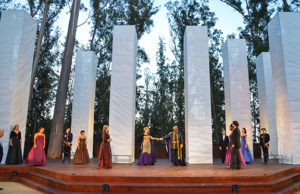
Set by Collette Pollard. Costumes by B. Modern
Which Hamlet?
For ardent Shakespeareans, the “insider baseball” for any production of Hamlet is which Hamlet we see. The text exists in three vastly different Renaissance versions. Two of them get most of the attention. The so called “Second Quarto” of 1604, and the First Folio of 1623 differ in length by some 150 full lines. Q2 contains an entire soliloquy that is cut from the Folio, and there are hundreds of minor wording changes. This production cut a good deal of the text, with some interesting minor rearrangements here and there, but generally followed the Folio version.
It is the third alternative that can provide, continuing our baseball metaphor, the real curveball. The “First Quarto” of 1603 is a bizarre text, half the length of the others and featuring what almost sounds like a paraphrase of the text to which we are accustomed. Most scholars believe that it is a version of the text put together from memory by actors, observers (or both) without consulting a written manuscript.
However odd it is, and Q1 is really odd, it has a few interesting features which might relate to it being pieced together after watching an actual performance. Most significantly, the scenes are in a different order. The most famous soliloquy in the canon, “To be or not to be,” sits at the start of Act II instead of the beginning of Act III.
Santa Cruz performs the piece in Q1 order, although it utilizes the wording from the F1 text. This makes a world of difference. Hamlet becomes far less indecisive and confused. In the typical order, Hamlet confirms his uncle’s treachery through a performance of a play-within-the-play that replicates the conditions of his murder of Hamlet’s father. He seems overjoyed at this, but in the very next scene he returns with his famous contemplation of suicide. Modern actors go through all kinds of psychological twists to make sense of this bizarre emotional reversal.
In Q1 order, however, (as performed at Santa Cruz) Hamlet is suicidal when she is not sure whether her father is a truthful ghost or a deceiving demon, but snaps back out of this depression once the playlet reveals the truth and never wavers thereafter. This is not only sensible, but thrilling. Eastwood Norris’ Hamlet is far stronger than that of most men I have seen play the role, flirting with madness to a far smaller degree, which is largely because of her own laser-like focus, but the less confusing order of events also propels her forward in a manner that is more palpably immediate and less intellectually abstract.
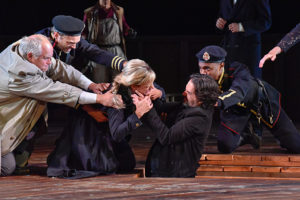
Mike Ryan (Horatio), Kyle Hester (Marcellus), Kate Eastwood Norris (Hamlet), Cody Nickell (Laertes), and Christian Strange (Barnardo) in Santa Cruz Shakespeare’s 2016 production of Hamlet 2016. Photo by Jana Marcus.
Performances of Note
The production features a number of very notable performances. Bernard K. Addison plays both the ghostly King Hamlet and the villainous King Claudius. Cody Nickell has the unenviable task of finding a way to keep the complexity in Laertes’ character, although an awful lot of social conditioning teaches us that someone who would plot the death of a woman (as Hamlet is in this case) is not just duplicitous but also a bully. Even viewed through that lens, however, he finds the redeeming humanity in the character. Mike Ryan is a solid and precise Horatio.
Patty Gallagher (a performer whose work I consistently admire) brings a pathetic depth to Polonius that I have rarely seen. She seems less a silly old fool than a woman who is hopelessly double-bound by the responsibilities she is given and the disempowering standards of behavior to which she is held (restricted?) while trying to achieve them. Although Eastwood Norris’ Hamlet provided a very interesting resonance in the shadow of Hillary Clinton’s achievement, Gallagher’s Polonius was equally reminiscent in another way as we saw and judged her quite differently than we would a man in the same situation.
Mary Cavett as Rosencrantz and Katherine Ko as Guildenstern are guileless schoolgirls, clearly out of their depth. In this one case, I worried about the difference casting women in the roles made. It was not their performances, which were impeccable, but the context. When I learned (spoiler alert) that Hamlet had substituted an order than ended with their execution, Hamlet’s declaration that “they come not near my conscious” proved the least sympathetic moment of the evening – a touch of calculated cruelty that made me cringe, and made me think about why it felt so different from how this moment usually plays.
See This Production? Absolutely!
Ryan’s leadership of SCS is brave, and in this case, Director Mullins delivered on his mandate and made a female Hamlet feel both inevitable and historic at once.
*Although we have not seen each other since, full disclosure is that Mullins was a classmate of mine in the Professional Theatre Training Program at Southern Methodist University in the early ’80s.
He were an excellent man: a review of MUCH ADO at CalShakes
May 30, 2016 § Leave a Comment
As has been their pattern for the last few years, the California Shakespeare Theater (CalShakes) has opened its season with a quirky, challenging take or adaptation of a Shakespeare play. (Last year it was an almost all-female Twelfth Night.) This year it is an adaptation of Much Ado About Nothing, which greatly streamlines the play, presented by a multi-ethnic and frequently gender-switched ensemble of eight.
Directed by off-Broadway fixture Jackson Gay, who also adapted the play with Kenneth Lin, the production is successful at condensing the sprawling plot into a tightly focused hour-and-a-half. It is especially entertaining when the gender-switched central couple, Beatrice (played by James Carpenter) and Benedick (played by Stacy Ross) hold the stage.
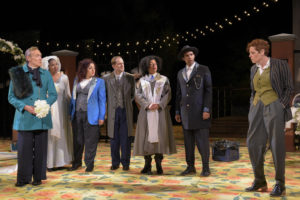
(l to r) James Carpenter as Beatrice, Safiya Fredericks as Hero, Denmo Ibrahim as Claudio, Anthony Fusco as Leonato, Rami Margron as the Friar, Lance Gardner as Don Pedro, and Stacy Ross as Benedick in California Shakespeare Theater’s production of MUCH ADO ABOUT NOTHING, directed by Jackson Gay; photo by Alessandra Mello.
Storming the Gates?
Conceptually, it is far murkier. Set, according to the advanced publicity, behind the scenes of “the biggest celebrity wedding in America,” where the catering staff acts out their pieced-together understanding of the story underneath the scandal-plagued ceremony they have just served, the adaptation succeeds best when speeding quickly past the issues of race and class it promised, in that same preview, to raise. Much Ado does not prove a very good vehicle for discussing income inequality or class privilege, largely because the original plot focuses so clearly on critiquing male privilege. Additional text by Kenneth Lin, mostly a smattering of amusingly snarky couplets, alludes to the notorious indifference of the one-percenters, but does little to further the social critique. (No rants from me against updating Shakespeare, or conceptual productions. I usually favor them. Just noting that, except in the arena of gender politics already present in the play, this particular concept did not have much to say.)
The location dictated by this concept (the untidy staging space behind a wedding venue) limited scene designer Erik Flatmo’s options. His realistic, but therefore messy, set worked well as a floorplan without giving us much to look at. The most prominent feature on the set, a second-story balcony where we are told the play’s thug, Borachio, created the illusion of seducing the confusingly named heroine, Hero, was not used for that, or really any, purpose. Of course that event is only related through exposition in the play, although it is often interpolated as a mime, but then if you are not going to stage it – echoing the issue with the overall concept – why is this feature there at all?
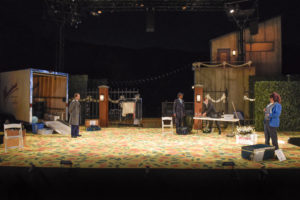
Erik Flatmo’s set for the California Shakespeare Theater’s production of MUCH ADO ABOUT NOTHING, directed by Jackson Gay; photo by Alessandra Mello.
Costume designer Karina Chavarin provides very effective pieces to be layered over the basic catering uniforms to indicate the fictional characters of the play. Visually, the heavy lifting is done by lighting designer Paul Whitaker, who not only shapes the stage with interesting compositions but helps us alternate between the framing device and the play itself with great dexterity.
Genderbending
What does work, and might have worked equally well without any added concept, is the virtuosity of the acting. The brilliant Anthony Fusco is underutilized in this production but alternates rigidly patriarchal Leonato with an “indignorant” Dogberry with speed and skill. Rami Margron, a company stalwart, is likewise used in the smallish parts of Margaret and Borachio, but single-handedly makes clear the power of cross-gender casting in the crucial but thankless role of the friar. Spoiler alert: after Hero is brutally rejected by her fiancé, her feudal lord and ultimately her father, it is the unassuming friar who steps forward to declare belief in Hero’s innocence of the charges of infidelity waged against her, and to provide the plan that ultimately resolves everything happily. In his one speaking scene, the friar explains that he knows Hero is telling the truth just by genuinely observing her reactions. Although in this production the character is still gendered male, watching a woman play the part provides a perspective on empathy that I have never experienced after seeing the role traditionally cast.
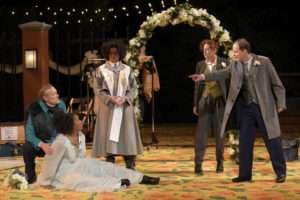
(l to r) James Carpenter as Beatrice, Safiya Fredericks as Hero, Rami Margron as the Friar, Stacy Ross as Benedick, and Anthony Fusco as Leonato in California Shakespeare Theater’s production of MUCH ADO ABOUT NOTHING, directed by Jackson Gay; photo by Alessandra Mello.
Stacy Ross gives us an original reading of Benedick through deftly handling the cross-gendering of her character so that she seems perpetually present as both the character and the underlying (female) cater-waiter presenting the story. Her intelligent interpretation of the part is informed by her gender, and we see her perspective in the way in which even she is surprised by the choices Benedick makes and the struggle to embody them.
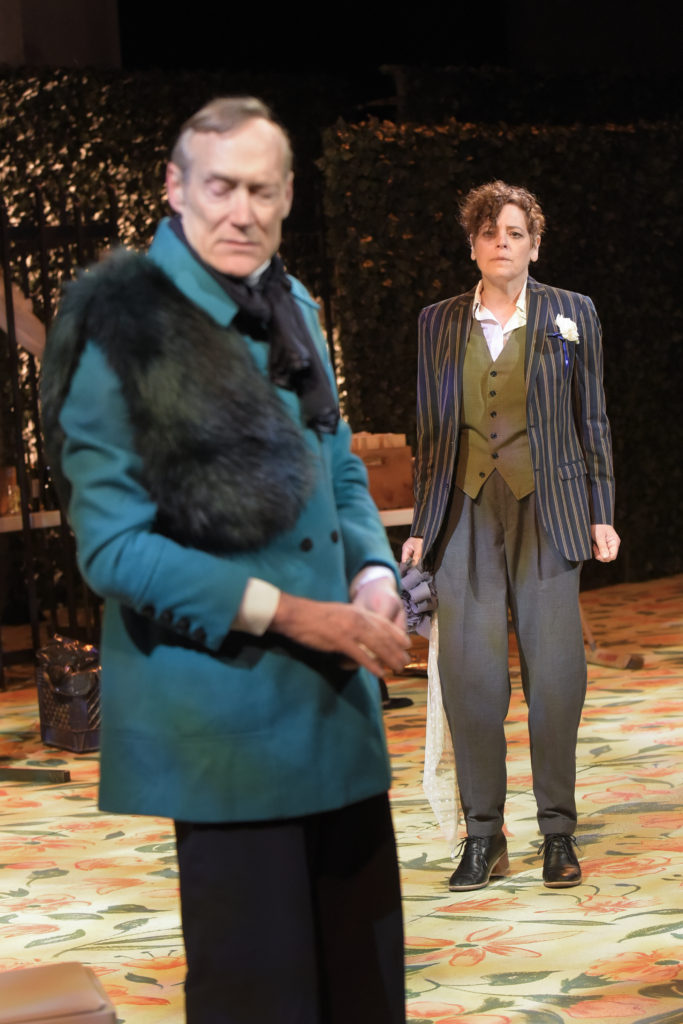
James Carpenter as Beatrice and Stacy Ross as Benedick in California Shakespeare Theater’s production of MUCH ADO ABOUT NOTHING, directed by Jackson Gay; photo by Alessandra Mello
The revelation of the night is James Carpenter in the role of Beatrice. He was seen a year ago cast perfectly to type in Pygmalion as Doolittle. It is hard to imagine someone less likely to play Beatrice, but he does it with such humanity and emotional grace that the part seems newly minted. Her pain and frustration reads as all the greater because it is clear (when situated on a male body) that they are entirely artificial limitations placed on her.
The versatile cast is rounded out by Patrick Alparone, Safiya Fredericks, Lance Gardner, and Denmo Ibrahim.
CalShakes is the big dog among Bay Area Shakespeare festivals. It has consistently high production values and standards. It is situated in the very diverse East Bay and has a great track record of developing and serving a contemporary audience. Much Ado does not quite deliver on its potential to comment on social disparity just down the freeway, but it is still a worthwhile night in the theatre–especially recommended for those who know the play well and are ready to see the traditional comedic war-of-the-sexes battle lines redrawn.
PS: CalShakes has a new artistic director, Eric Ting, who welcomed the audience warmly for this opening night but it will be later in the season, when he makes his directorial debut with Othello, before we get a full sense of what he will bring to the company.
Details:
California Shakespeare Theater’s production of Much Ado About Nothing by William Shakespeare, adapted by Kenneth Lin and Jackson Gay, with additional text by Kenneth Lin.
Directed by Jackson Gay. Designed by Eric Flatmo (set designer), Karina Chavarin (costume designer), Paul Whitaker (lighting designer), and Olive Mitra (sound designer/composer).
May 25–June 19, 2016
(Tuesdays through Thursdays at 7:30pm, Fridays and Saturdays at 8pm, Saturday Matinee June 18 at 2pm
Sunday Matinees at 4pm)
Bruns Amphitheater, 100 California Shakespeare Theater Way, Orinda, CA 94563
Long Live the Revolution: a review of HAMLET at Shotgun Players
April 30, 2016 § Leave a Comment
A generation ago, there were two surefire claims to bragging rights among serious Shakespeare playgoers: that you had personally seen one or both of the two most revolutionary productions of the 20th Century–Peter Brook’s Midsummer and Steven Berkoff’s Hamlet.
Brook’s white box set became famous, and going even further towards stripping a play down to its essence, Berkoff reduced Hamlet’s spectacle to a single taped white line across the floor, inspiring an entire generation to a more visceral and less pictorial approach. For those who (like me) missed those heady days, the spiritual successor to Steven Berkoff’s famously minimalist production has come to Berkeley’s Shotgun Players.
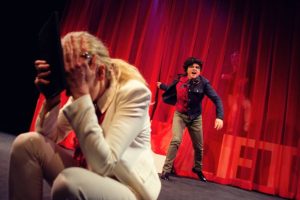
El Beh as Hamlet and Beth Wilmurt as Gertrude. (I think that is David Sinaiko playing the dying Polonius just visible through the curtain. ) This is not the same casting configuration I saw, as explaned below…
Shotgun Shakespeare
Shotgun is celebrating its 25th anniversary season, and it is hard to imagine any production that could better convey their aesthetic, showcase their artists and speak to their particular audience than their current offering. Directed by long-time company member Mark Jackson*, the production features a four-woman/three-man, vaguely androgynous, multi-ethnic ensemble presenting a considerably shortened–and therefore very fast moving–version of the work. Nina Ball’s set is a bi-level black platform with a layer of intense red curtains behind each level, and six chairs that mostly live along the side walls of the theatre but occasionally make their way onstage as a throne, a bed or a grave.
Jackson’s staging is clean, and in his signature style, very physical. Isolated iconic gestures associated with each character are the dominant motif. Christine Crook’s costumes are simple, suggestive bits and pieces – jeans, sweaters, jackets, coveralls, and a long, flowing blouse for Ophelia. Heather Basarab’s lights (and deep shadows) are intense and often directionally moody. Matt Stines’ blatantly theatrical sound design is purposely foregrounded, most prominently in the long fencing scene at the end of the play–noisily fought with invisible rapiers. Perhaps the most noticeable visual element of the production is that all the actors carry (but never consult) scripts with them, which they use as props whenever possible.
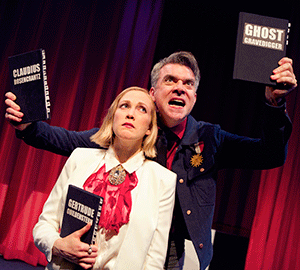
Kevin Clarke and Megan Trout, as Hamlet upbraiding his mother with the images of his father and uncle. (This is also not the cast configuration I saw.)
Audience Partnership
As one might expect of Shotgun, the work is raw, rough, and unsentimental. Berkeley’s sophisticated audience is called upon both intellectually and imaginatively to extend the performance far beyond what is materially presented in front of them. The cutting is severe. The opening scenes on the battlements, the traveling players, Fortinbras, and most of Act IV all disappear.
As is often the case with minimalist productions, so much is gone that the production is probably incomprehensible to anyone who does not already know the plot–but it is a safe bet that virtually no one in Shotgun’s audience has trouble filling in the rather massive holes in the remaining narrative. As but one example, Hamlet’s soliloquy that begins “Oh, what a rogue and peasant slave…” is (mostly) retained, but since it does not follow on the appearance of the troupe of traveling players, Hamlet’s musing on surface appearances versus deep feelings now references the real actors in Shotgun’s production instead of the pretend ones visiting Elsinore. That is a logical leap a couple of levels of metaphor removed from the play as traditionally presented, and probably can’t be made unless you know the original context–but it tells you a lot about Shotgun that it presented no problem to anyone on the night I saw the show. (The actual performance of the players’ The Mousetrap, for those who are worried, is reassigned to Hamlet and Ophelia.)
Given the severity of the cutting, reassignment of lines, and occasional rearrangements of the order of speeches, I would have preferred a little more dramaturgical expertise behind the cast’s collective cutting. I might personally have encouraged consideration of the otherwise dubious First Quarto’s placement of “To be or not to be,” which makes far more sense when located much earlier in the show, as Q1 has it, especially when it is laid as bare as it is in this much-shortened version. It is part of the dedication to the ensemble, however, that dictates an equal voice for the actors in matters like this–matters which are usually deferred to “experts” and decided long before the actors are even cast.
Shakespeare Roulette
The production would be interesting enough if it was conventionally cast and presented, but it has an extra level of artistic risk and emotional excitement because it performed in what the company calls “roulette style.” All seven cast members (and an understudy) have memorized the entire play, and just before the performance a random drawing determines which actor will play which part(s) that night. As it happens, I saw the closest fit to a traditional Hamlet (actor Nick Medina) play the title role on the night I attended, and perhaps that made it more easily digestible, but I also saw company member Kevin Clarke play Ophelia – a sensitive and beautiful performance despite the fact that he made almost no attempt to impersonate a young woman. The dynamics of the tragedy emerge from the circumstances, not from the actors’ appearances and personalities. Of course, no two performances are even remotely the same.
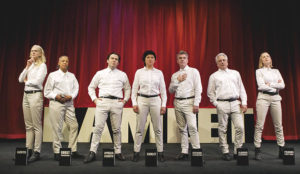
Beth Wilmurt, Cathleen Riddley, Nick Medina, El Beh, Kevin Clarke, David Sinaiko, and Megan Trout prepare to pick their roles for the night in “Hamlet” at Shotgun Players. (Photo by Pak Han)
Not every artist would be willing to place him/herself under this pressure, but it is typical of Shotgun’s players that they are attracted to the unorthodox and the risky. On the night I saw the show, El Beh (last seen at Shotgun as Emily in Our Town) played Laertes, and Cathleen Riddley played Claudius (and Rosencrantz). That two women of color were randomly placed in the roles of the two violent male antagonists was, to say the least, illuminating. The youngest person in the cast, Megan Trout, drew the oldest characters: the Ghost/Gravedigger. The evening was filled out with Beth Wilmurt as Gertrude/Guildenstern and David Sinaiko as Polonius/Osric.
The particular performance that I saw was not word perfect, but the minor wobbles and unapologetic prompting did not dull the sense of danger emerging from a previously staged, but still almost improvisatory, first “run-through” in this configuration. Like the rehearsal period that actors so cherish, discoveries were being made right on the spot, and that forced both actors and audience members to pay close attention.
Designed for Multiple Viewings
This is not what one of my colleagues calls “gift shop Shakespeare.” It is not pretty, celebrity studded, or made topical. Jackson and his cast are excavating the essential text from under a lot of accumulated baggage, and what emerges is often highly original and gut wrenching. (I was particularly struck by the stunning manner in which Gertrude’s strangely incongruous description of Ophelia’s death was recontextualized in a way that finally made sense.) That it can also be, from moment-to-moment, a bit hit-or-miss is beside the point. After all, you can always come back to another performance–a possibility made easy because Shotgun sells tickets in three performance packages–to see it all handled differently another night. From what I could ascertain at my particular performance, a lot of patrons were seeing the production for a second time. It is a trend that I predict will continue with this fascinating production as it continues its run, as part of a season-long repertory, through January 2017.

*As a matter of full disclosure, (although we have never worked together directly) both Mark Jackson and Matt Stines have been my colleagues at San Francisco State University, and Megan Trout is one of the program’s graduates.
A Trumped-up RICHARD III at Marin Shakespeare
September 19, 2015 § Leave a Comment
Robert Currier’s direction of Richard III at Marin Shakespeare Company is almost completely lacking in subtlety, and his star, Aidan O’Reilly, gives a performance devoid of nuance. I loved it. You see, that is how this production completely captures the current political climate. It is thoroughly relevant and wonderfully insightful about the sad state of partisan discourse in our time!
Politicizing Approaches
Richard III was the earliest of Shakespeare’s Machiavellian anti-heroes, in a strain that would peak with Iago. He is usually played, as in Ian McKellen’s outstanding film rendition, as a cynical fraud, publicly appearing to be the opposite of his evil, scheming true self—which he reveals only in soliloquy. Politically, productions using this approach often seem reminiscent of contemporary right wing pundits warning of the dangers of smooth talking lefties. (Surely I am not the only one who has noticed this rhetoric is usually applied to characterizing Barack Obama, and before him, Bill Clinton as two-faced politicians whose silver-tongued exteriors mask their real beliefs.)
Refreshingly, this is not the approach in this fascinating production, which sits somewhere on the opposite end of the spectrum. O’Reilly’s Richard is anything but smooth. He is loud, brash, and charmless. He says whatever his victims audiences want to hear, but without the slightest pretense (even in the moment) that he actually believes any of it. He preys on the gullibility of those who seem incapable of conceptualizing the existence of self-serving insincerity. Produced during the time period when Donald Trump has suddenly leapt to the top of the leader board in the crowded Republican presidential field, it is not hard to identify a contemporary referent. What might have seemed an unbelievable reading even a year ago, now seems chillingly plausible.
This interpretation says a lot about Richard, but more about his observers who seem to parse his words autistically, without the ability to read the attitudes and emotions that lie behind them. It is a very different production when the focus is not on Richard as imposter, but on everyone else as self-deceiving.
Representing Disability (or Not)
I admit to being thoroughly caught off-guard by the whole approach. All of the pre-publicity for the show focused on the fact that O’Reilly has been legally blind since childhood from retinoblastoma, a rare form of cancer of the light sensing cells of the eyes. Given the enormous amount of focus on questions of representation (that is, who can—and should—represent the characters in the plays) on the stages of Bay Area Shakespeare festivals this summer; along with a great flurry of rehabilitation of Richard’s reputation since his long-lost skeleton was recovered from under a Leicester parking lot in 2012; I was anticipating that O’Reilly might explore (and possibly reinterpret) this most famously disabled Shakespearean character through the metaphor of his own experience. That he did not do. Instead, he characterized Richard’s disfigurements quite conventionally, and as for his own challenges—those were handled so invisibly that one forgot all about them almost immediately. Given the obstacles, including some pretty complex stage combat, it is an amazing performance, but one in which his disabilities were disguised rather than directly referenced.
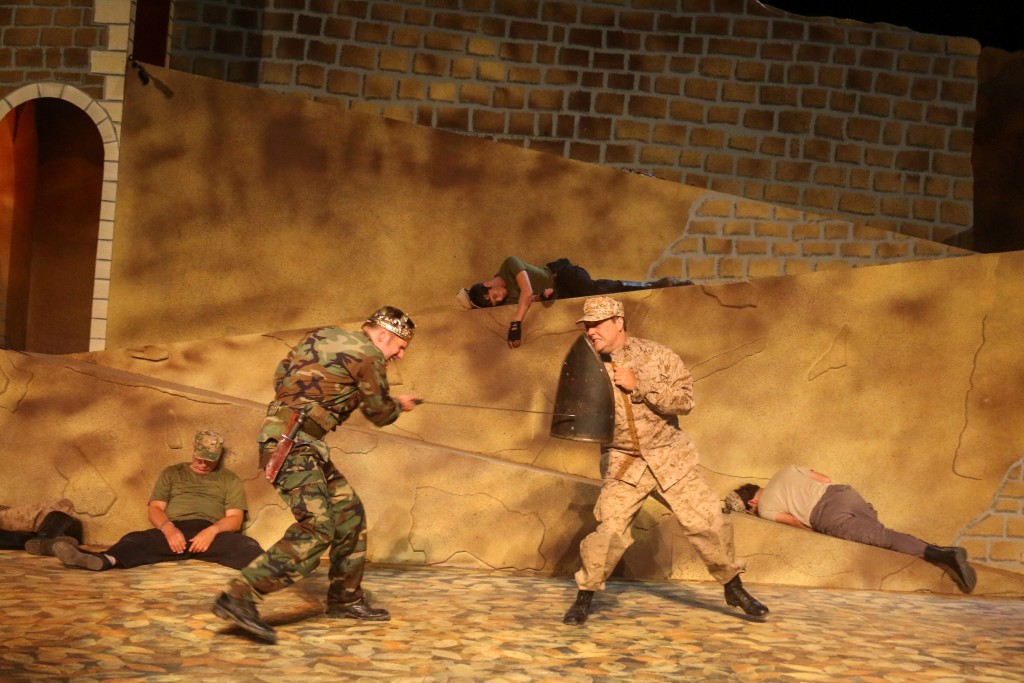
Following a night of ghostly visits by those slain in Richard’s quest for power, Richard III (Aidan O’Reilly) and Lancastrian heir, Richmond (Jackson Currier) meet in battle.
Supporting Cast
The supporting ensemble for this production is the strongest of the season. Michael Ray Wisely is brilliant as Buckingham, the one courtier who sees Richard for what he is and willingly accepts a role as co-conspirator (a la Ted Cruz?), but fails to realize that he is as dispensable as everyone else once he has served his purpose.
Phoebe Moyer as the prophetic, but powerless, former queen Margaret is haunting. The most complex performance of the night is given by Elena Wright, as the mother of the two young rightful heirs to the throne that Richard murders, as she desperately maneuvers to save her surviving daughter. (Those two children, the “princes in the tower,” are played by genuinely outstanding child actors Patrick Ewart and Carl Robinett.)
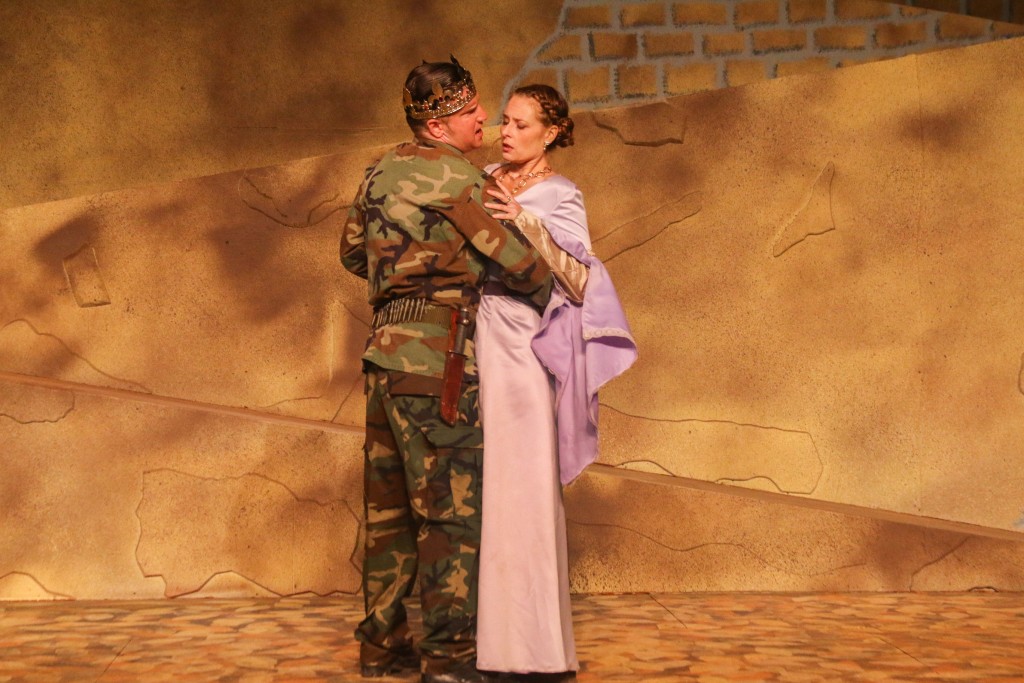
After killing her two sons, Richard III (Aidan O’Reilly) insists that Queen Elizabeth (Elena Wright) arrange for him to marry her daughter.
Several other standouts in the large cast included Michael Schaeffer, Chris Hammond, and Steven Price—all of whom play multiple roles; and Davern Wright, who is chilling as Richard’s henchman Catesby and then proves to be unexpectedly hilarious in the scene where he “spontaneously” exhorts the crowd to support Richard, reading his assigned part off note-cards.
Unfortunately at the performance I saw, Jackson Currier’s voice failed him in the closing sequences when he was playing the hero Richmond (after earlier playing a terrific coke-sniffing, clueless brother to the Queen) so the final moments of the play, which depend on a pair of Henry V-like orations, fell rather flat. Richmond is not the focus of this production, however, so it mattered much less than it ordinarily might.
Camo and Glitter
Abra Berman’s costumes for the production are a mix of period finery layered over contemporary camo fatigues, a perfect metaphor for the way beautiful language is hung on top of pedestrian motives throughout the play.
Jackson Currier’s set, used for multiple plays this summer, is nicely refurbished for this particular play. Joel Eis provides the distinguishing set décor and props.
In the end, it is Richard Currier’s direction that makes this production. Currier is difficult to read, as he usually eschews conceptual approaches, and works hard to stay out of the way of his actors. This production has the strongest viewpoint of any of his I have ever seen, but whether that is intentional or simply a by-product of the zeitgeist is unclear. Whichever, it is certainly provocative!
Everyone’s a Badass: A review of MACBETH at Santa Cruz Shakespeare
August 12, 2015 § Leave a Comment
In Kristen Brandt’s production of Macbeth, Scotland’s aristocratic class of Thanes is composed equally of hulking men straight out of Braveheart and badass, broadsword-wielding warrior women. This is far from the only way that actresses are especially prominent in Santa Cruz Shakespeare’s current offering, but it is the most viscerally startling. Particularly, the magnificent Greta Wohlrabe’s Banquo (absolutely gendered female without having to become Banqua…) is unforgettable from her first bloody appearance.
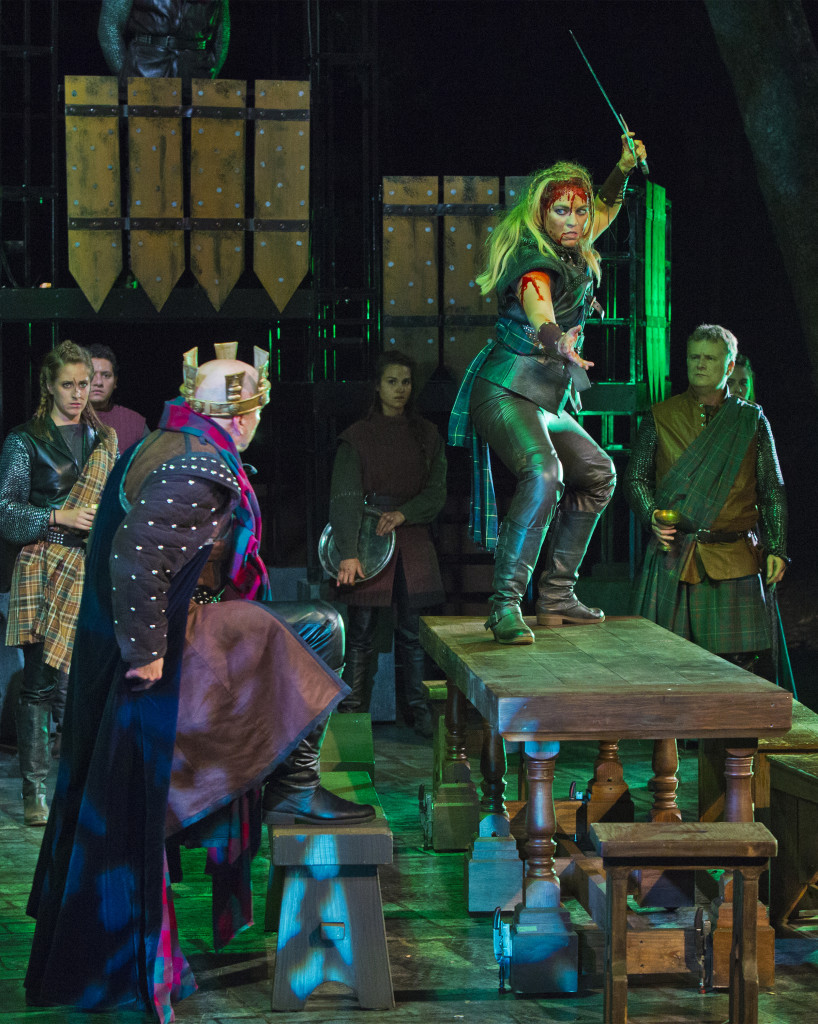
Steve Pickering (Macbeth) and Greta Wohlrabe (Banquo) in Santa Cruz Shakespeare’s Macbeth by William Shakespeare. Also pictured (l. to r.): Madison Kisst, Carlos Angel-Barajas, Kipp Moorman, and Sarah Traisman. Photo by rr jones.
Malcolm, Princess of Cumberland, played by Sierra Jolene; and the Thane of Ross, played by Patty Gallagher, offer more variations on the theme—as do several ensemble players—but even in their less fierce portraits we are closer to Mad Max or an episode of Vikings than the typical Scottish setting.
Sisters and Weird Sisters
Focusing us on women immediately, the play opens with an interpolated scene in which the three “weird sisters” are arrested and accused of collecting body parts from the battlefield for the purposes of witchcraft. This seems to place us in the medieval past, but visually B. Modern’s leather heavy costumes on Nina Ball’s largely metal set combined with the anachronistic female Thanes equally suggested a post-apocalyptic future. Lady Macbeth wears a pre-Raphealite gown that would have made Ellen Terry proud a century ago, but most of the company (women and men) seems perpetually dressed for battle. (I saw an afternoon matinee in the outdoor theatre; Kurt Landisman’s atmospheric lights were effective even though muted.)
The extensive re-gendering of characters (aided by extensive pronoun changes and other textual adjustments) may be more a product of the company’s gender parity policy than the director’s vision, but the immediate effect is a fresh look at the play. Lady Macbeth is tough, but given the world of this production, she does not seem particularly villainous—as an unending stream of misogynistic versions would have her—as much as a product of her times. Her statement that she would kill her own child before backing down on her word (as she accuses Macbeth of considering) seems not monstrous, but simply a matter-of-fact. In director Brandt’s hands, she is also not easily erased. When her death is announced, it is by a character carrying her corpse in a spectacular coup-de-théâtre. The body is immediately handed to Macbeth, and he holds it painfully and awkwardly until he goes forth to fight his final battle.
Oddly, in this world, it is Lady Macduff who seems out of place when she is unwilling or unable to defend herself. Her helplessness does not diminish the tragedy of her murder but it does seem surprising given the number of expert swordswomen we have seen, and have come to accept as unremarkable, throughout the evening.
Feeling as Men
In this particular environment, gender roles are not associated with extremes of masculinity and femininity. Both Steve Pickering as Macbeth, and Toby Onwumere as Macduff, take advantage of this to play more wildly emotional characters than we are used to seeing in these parts. It is a fearless cast, but I would not have predicted that this would manifest in leading men as the ability to play their fears and pain so openly. This was the great revelation of the evening. I did not realize how much, in most Macbeths, the Thane’s masculinity is expressed by emotional detachment and dehumanization until I saw this portrayal which was so vitally alive. Pickering was deeply emotional throughout, especially in soliloquy, and if anything led to his defeat it was that Onwumere (as Macduff) was even more so.
Not everything about the reworking was successful—Malcolm’s equivocating test of Macduff was as interminable as ever, for example—but seeing so much in an altered context kept the production intriguing even when the pace slowed in the second half.
Brandt’s interest was largely in the psychology of character, with the supernatural element substantially less prominent than the Rupert Goold film starring Patrick Stewart or other recent versions. When it came time to kill Banquo, she did select Seyton (Darek Riley) to play the mysterious third murderer, but the insistent pronunciation “SEE-ton,” rather than the punning “Say-tan,” told us that in her vision characters control their own fates rather than being manipulated by evil. In this production, Fleance escaped his assassination because the murderers were inept, not because he was protected.
Brandt is an exciting director. Her production of Merry Wives of Windsor in the same venue a year ago was a revelation because—surprise!—it focused on the wives and not Falstaff. It is not fair to suggest that her production of Macbeth likewise shifts focus to the women. What it does do is re-contextualize both the women and the men so that we can see the story without quite so much sexist baggage. That is a great gift.
Macbeth
August 4–August 30, 2015
Seen August 9
Because It Is the Right Thing To Do: A Review of ROMEO AND JULIET at the San Francisco Shakespeare Festival
August 11, 2015 § 1 Comment
The Artistic Director of the San Francisco Shakespeare Festival, Rebecca J. Ennals, is leading the charge to broaden onstage opportunity in the Bay Area. Her democratizing impulses are prominently on display in her production of Romeo and Juliet, now touring area parks. In addition to featuring actors of color in close to half of the named roles, the production also achieves gender parity by casting actresses in a number of roles that are gendered male. More subtly, the cast also blurs the usually sharp distinction between “character” actors and “leading” actors by utilizing a wide variety of body and voice types in unexpected places.
Improving access onstage is a logical extension of the Festival’s mission of offering free Shakespeare in the park (along the Joe Papp model) to a broad spectrum of community audiences. The performances are enormously popular, playing to large crowds at all four of the Bay Area parks in which performances are held over the course of the summer.
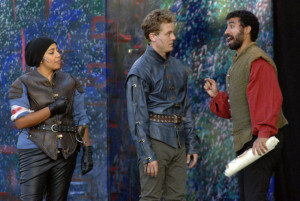
Regina Morones, Carl Holvick and Mohammad Shehata as Benvolio, Romeo and Peter. Photo: Doug Jorgensen
The Concept Is that There Is No Concept
Interestingly, the much-improved diversity is not directly featured as an artistic statement about R&J at all. It is generally treated as invisible in this production. (Or should we say transparent?) That Romeo is a fairly conventionally cast white male who is convincing as a juvenile while Juliet is played by a powerful African-American “leading lady” (rather than an ingénue) is not foregrounded in any way. No West Side Story-style explanations for the feud here.
That Tybalt is played by the obviously female Carla Pantoja, albeit with a false beard to spell out the gender of the character, is just a matter to be taken in stride. She neither makes great effort to hide her underlying gender nor to use it to comment on the mindset of the man she is playing. Regina Morones’ Benvolio is more masculine in execution, but neither her ethnicity nor actual gender is disguised.
If any political point is made by these decisions, it seems to be that in an ideal world they should not matter so very much – and for the most part the production upholds this viewpoint. It is successful as a narrative in which we look through gender, ethnicity, and even the actors’ “types” to see the raw story. Often the surface appearances are contradicting or complicating what we see onstage, but the production offers no consistent viewpoint from that effect. The only convention employed is that we, as audience, are expected to look through the specific representations to a universal theme.
Similar Efforts
It is an interesting and admirable experiment. Similar efforts are going on in many Bay Area Shakespeare festivals this summer. California Shakespeare Festival (known locally as CalShakes) produced an almost all-female Twelfth Night earlier this season in which the actresses quite pointedly (sometimes with hilarious crudity) “commented” on their male personas. The Sacramento Shakespeare Festival produced an original practices (thus all-male) Romeo and Juliet, and then balanced it with an all-female As You Like It. Santa Cruz Shakespeare, meanwhile, is pursuing gender parity in its productions of Much Ado About Nothing and Macbeth, by changing the gender of characters along with all references to their gender in the texts.
In these contrasting examples, the diversity issues are carefully contextualized. Although I prefer this approach, Ennals’ choices are interesting precisely because she offers no internal explanations. The effect is sometimes distracting—I overheard quite a few confused murmurs from nearby audience members—but the crowd eventually accepted that the casting was both color- and gender-blind and stopped trying to read anything more into it.
Uneven Performances
The quality of the performance is uneven, but not because of anything having to do with the diversity choices. The scene painting is amateurish and Ashley Holvick’s costumes, although much better executed, are conventional. Ennals’ staging is frequently messy, and occasionally just odd. (The “morning after” scene, for example, is played on stage level, so the balcony-less Romeo is forced to jump down into the crowd in order to have any sort of descent.) The extensive doubling is successful, although at one point it becomes logistically complicated: Phil Lowery’s Friar Laurence having to be onstage in the final scene means that his Lord Montague cannot be. In the only significant rewriting, therefore, Lady Montague appears onstage in the final scene as peacemaker after the surprising news (to those that know the show well) that her husband has just died.
Romeo and Juliet are compellingly portrayed by Carl Holvick and Lauren Spencer, respectively. Their chemistry and energy are engaging. Spencer’s Juliet is more mature from the outset than any I have seen in years, but she is more effective in the last half of the show than most because she is not childish and she clearly understands the choices she is making. (It is actually kind of refreshing, for once, not to have to focus so hard on overcoming the inherent creepiness of men drooling over a thirteen-year-old.)
Gwen Loeb is wonderfully loud and bawdy as Juliet’s nurse, and in a doubling returns as the usually absent Lady Montague for the final scene, taking over all of her husband’s traditional lines. Phil Lowery’s Friar Laurence is earnest at every turn, and more sympathetic than usual. Mohammed Shehata is a powerful Prince Escalus, and is unrecognizable in his doubling as Peter, which speaks to his versatility. The rest of the cast is serviceable, without anyone standing out in either good or bad ways.
The show features two very surprising—and I think less than successful—choices of convention: in the first, whenever the play features a rhyming couplet with an historic rhyme (that is, one where the words once rhymed but because of pronunciation changes no longer do, such as love/prove or die/remedy) the original pronunciation of one or both is restored to regain the rhyme. That is actually fascinating, but certainly seems odd when numerous other original pronunciation issues—such as preservation of puns or scansion—are ignored.
The second is that after the epilogue, a traditional jig is performed by the full cast as the curtain call. It is not quite historically correct as original practice, as such jigs were separate entertainments (usually with risqué lyrics to songs in addition to the dancing) in Shakespeare’s time and not curtain calls. It was also not quite effective on its own terms since it broke the somber mode without transition or explanation. In these cases, the lack of contextualization (which worked for the casting) was problematic.
As of this writing, the show has finished its run in Pleasanton and Cupertino. It plays Saturdays and Sundays in Redwood City through August 23rd, moves to the Presidio in San Francisco through September 13th, and finishes its run at McLaren Park in SF, on September 27th.
Romeo and Juliet
San Francisco Shakespeare Festival
June 27 – Sept. 27, 2015
Various Locations throughout the Bay Area
Seen August 2, 2015
Never Anything Can Be Amiss: A Review of A MIDSUMMER NIGHT’S DREAM at Portola Valley Theatre Conservatory
August 2, 2015 § Leave a Comment
In their current offering, The Portola Valley Theatre Conservatory creates a conceptually-exciting, immersive staging that engaging explores the contrast between the soul-crushing city and the wild forest at the thematic heart of A Midsummer Night’s Dream.
Portola Valley is a rustic coastal California town, so bucolic that it is hard to believe it is only a half-hour south of bustling San Francisco, and within easy hiking distance of Stanford University. Tucked in between two large land preserves, it is a small dot of civilization placed amidst the giant redwoods. PVTC utilizes this arrangement in its site-specific setting to the fullest.
Site-specific and Immersive
The concept is initiated when one’s reservation is confirmed with a charming (and very contemporary) e-mail in the form of an invitation to Duke Theseus’ upcoming wedding. Along with the ubiquitous engagement photo, it gives the time and place, with a suggestion that the dress code is “layers” and guests might want to bring insect repellent.
Arriving at the site, which turns out to be a local protestant church, one is greeted at the edge of the parking lot by wedding ushers who – completely in character – apologize profusely that things are not quite ready for the ceremony, and in a disturbingly realistic scenario, ask the small audience to cool its heels outside while last-minute arrangements are completed.
When we are finally herded inside, we are led first to a small set representing the office of a wedding planner complete with piles of bridal magazines, catering menus and other commercial paraphernalia that overburdens modern weddings. The contemporary tone is reinforced by Hippolyta (Sarah Benjamin), who wears a t-shirt with a variation on a familiar meme that says, “I can’t keep calm and carry on, I am the bride.” The audience shares the space with the actors, standing around the edges or just sitting down on the floor to watch Egeus intrusively demand that the distracted Duke (Bryce Chaddick) force his daughter, Hermia, (Lydia Cuffman) – against her will – to marry Demetrius (William J. Brown III), instantly identifiable as a hipster because he is wearing his fashionable sunglasses inside.
Take a Hike
After the first scene plays out, we are urged to follow Hermia and her beloved, Lysander (Matt Waters), into the woods where they are fleeing in hiking gear – complete with backpacks and sleeping bags. They are tailed by Demetrius’ ex, Helena (Alanna McNaughton) and by Demetrius, himself. While heading out toward a redwood grove, we encounter the rude mechanicals preparing their play in a courtyard, and pass a strategically placed fairy queen (Cheryl Goodman-Morris) preening over a changeling boy (John Max Byrne).
The second and third acts of the play are staged in the midst of a towering redwood grove, which is directly referenced in the performance in a clever substitution for Shakespeare’s hawthorn brake. (In a similar textual alternation, they will discover in the almanac that not only does the moon shine when they need it, but that it will be the Blue Moon that actually graced the performance.) Although conveniently lit with theatrical instruments and accompanied by Shane Turner’s live score, it is still the dust, stones, sticks and pine scent in the clearing where we gather that make the long night in the woods tactile and immediate. Kevin Gibbs is credited with the “Aesthetic Design.” Even when “off-stage,” fairies hover in the shadows and the sound of the living forest is always present. The scene seems literally enchanting.
My favorite piece of staging happenes on the trip back from the woods, when we observe Bottom’s friends anxiously scouting the horizon for any sign of him – all sitting on the parish hall rooftop. Talk about site-specific! Later we are led back inside to an interpolated, but nicely moving, triple wedding in the chapel, featuring a beautiful tenor solo by Don Gustafson (who also plays Egeus.)
From there we finish our evening on a candlelit patio, drinking champagne and munching petit-fours while (along with the Duke and his party) we enjoy the heartfelt entertainment presented by the rustics. (Ashley Pogue, Andrew Saier, Mark Goodman-Morris, Angela Khalipa, and John Kissel make up this motley crew, along with Andrew P. Quick in the always scene-stealing role of Flute/Thisbe.)
I’m Feeling It
By far the most interesting part of the evening was director Noëlle GM Gibbs’ immersive staging, perfectly fitted to the play. Her conceptual aim sometimes exceeded the grasp of her largely amateur cast, but the aim was, nonetheless, always true. Is there any place that better represents the unromantic excesses of social conformity than a wedding planner’s salon? Conversely, can there be any better way to realize the mystic power of nature than to take us – even a little way – out into the forest? (What was that sound, anyway, and what did I just step on?)
Having seen Midsummer dozens of times, I cannot recall having ever experienced the woods so powerfully. The visceral power of immersive staging, however forced it may initially seem, can transform an ordinary performance into a fully absorbing aesthetic experience as you begin to feel yourself part of the action and the environment becomes a character in the drama.
Unsurprisingly, the Equity guest artist William J. Brown III, as Demetrius, gives the best performance of the evening. (Brown is the Artistic Director of the Arabian Shakespeare Festival, and an actor whose work I have previously admired.) Matt Waters as Lysander and Bryce Chadwick as Theseus also give especially compelling performances.
This production gives unusual prominence to the lovers, and their journey of self-discovery over the course of the night is treated without condescension. They are funny, but more than farcical. The inability to know who we are when overburdened by the demands of civilization, and the liberation of finding our natural selves, emerge as serious themes for once. (Brown’s terrific moment of conversion upon waking from his night in the woods and realizing that he really does love Helena is about as good as acting gets.)
The evening was certainly not without its deficits. The scansion was something of a disaster throughout, and the fairies were garishly costumed Victorian conceptions surprisingly out-of-keeping with natural woods in which they were located. If ever wildly folkloric, instead of tame balletic, fairies were called for, this was the time!
Still, given a play that so thoroughly praises and celebrates the effective sincerity of amateur actors who are giving it their best shot, it would be churlish to deny their winning charm in this case. (I’ve certainly witnessed many fully professional productions that were both less interesting in their ideas and less engaging in their presentation.) Life and art converge in the final scene, where both the characters and their real-life interpreters rise to the occasion when the moment calls for it, and the effect is deeply moving. This is Shakespeare’s love-letter to the theatre, and PVTC’s innovative production makes us see it – no, experience it – freshly and intensively.
A Midsummer Night’s Dream
Portola Valley Theatre Conservatory
July 30 – August 2, 2015
Seen (under the Blue Moon) on July 31
Comedy and Emotion: A Review of THE LIAR at Santa Cruz Shakespeare
July 28, 2015 § Leave a Comment
“Emotion and comedy are enemies,” wrote the great French philosopher Henri Bergson, in a famous essay on humor. Santa Cruz Shakespeare’s beautiful, but strangely heartless, production of The Liar (adapted by David Ives from French neo-classic author Pierre Corneille, who in turn had adapted it from Spanish Golden Age writer Juan Ruiz de Alarcón y Mendoza) is a study in how difficult finding balance can be. There are some terrifically funny scenes in this very pleasant comedy, but the overall effect was oddly cynical about both love and honesty.
Neoclassic Comedy in “Transladaptation”
Since its premiere in 2010 at the Shakespeare Theatre in Washington, D.C., which commissioned this loose translation/adaptation, Ives’ version has become a staple of the Shakespeare Festival circuit. (In the Bay Area, Marin Shakespeare performed it in 2012, in a well-reviewed production I did not see. The following year Livermore Shakespeare Festival performed a version that, as I said in my review, I found charming.) Ives plays with language amusingly in a witty, anachronistic iambic pentameter version that tells the story of a young rake-on-the-make, Dorante, who is perpetually incapable of telling the truth and his hired servant, Cliton, who is equally unable to tell a lie.
Ives is, of course, a well-known playwright of absurdist-flavored comedies of his own devising, especially Venus in Fur – and his screwball rhymes, silly puns, and sly insertion of contemporary observational comedy explain exactly why the Shakespeare Theatre chose him to create this new version of The Liar.
It is Better to Look Good than to Feel Good (Or Is It?)
In Santa Cruz, Nina Ball’s beautiful set, essentially consisting of life-sized black-on-white architectural renderings, and David Mickelson’s elaborate period costumes created a gorgeous spectacle. (I saw an afternoon performance in the outdoor redwood glen SCS uses as its current performance site where Kurt Landisman’s lighting design was not readily discernible, but I have yet to see a design of his that I did not admire.)

Toby Onwumere (Cliton), Brian Smolin (Dorante), and Mary Cavett (Clarice) in David Mickelson’s costumes. All photos by Shmuel Thaler.
Much of the action is farcically mechanical, and when that is the case (like the comings and goings of “a set” of identical twin serving maids with opposite temperaments, played to great effect by Melinda Parrett), Art Manke’s direction is meticulous. Fight choreographer Kit Wilder created a terrific mock duel involving imaginary rapiers that extended that precision from the ridiculous to the hilariously sublime.
More than a Farce
The play is more than a farce, however. Our lying hero, Dorante, is using his talent for prevarication to pursue a young woman who has caught his eye, and in the manner of romantic comedy that leads to an eventual love match. In this case, however, too much comedy becomes the enemy of emotion. It is hard to root for Dorante, or at least Brian Smolin’s chipper but strangely charmless rendition of him because, while his flippant self-absorption got the verbal antics right, it created little empathy. The young woman – or as soon becomes apparent, women – who so entrance him were played by Sierra Jolene and Mary Cavett with wit and verbal dexterity, but as so calculating that it is hard to identify with them, either.
As I observed about Santa Cruz’ other offering in the current repertoire, exploring the callowness of youth does not an evening make. In their outstanding production of Much Ado About Nothing, an engagingly emotional supporting cast provides depth that the youthful leads cannot. There is much less opportunity for such humanity in Ives’ play, but even Kurt Meeker, as Dorante’s long suffering and endlessly forgiving father, stays in key with the rest of the production by playing the part with an emotional distance at odds with the sentiment implicit in the script. The cumulative effect is chilly. When the clever resolution is finally reached, although amusing on a surface level, it is hard to care, and not even clear that it is a good thing.
This peculiar outcome is partially the result of the artificiality of the elevated playing style, partly because of the mask-like quality of the exaggerated make-up, but mostly because the emotional depths of the narrative are left unplumbed. The essential ingredients are all there, but as in a soufflé, it requires delicate handling to makes it rise. The good news is that there is plenty of time left in this run for this gorgeous production to find its emotional balance.
The Liar by David Ives
Playing through August 29, 2015
Seen on July 25
Smart Choices, More Voices: A Review of MUCH ADO ABOUT NOTHING at Santa Cruz Shakespeare
July 26, 2015 § 1 Comment
Mike Ryan is making a lot of smart, invigorating decisions as Artistic Director at Santa Cruz Shakespeare, but the smartest of all might be to feature his own talents as Benedick in their current production of Much Ado About Nothing. He is an exceptional actor, generally under-utilized in dazzling cameos and featured side-kick roles. He is evenly matched by the wonderful Greta Wohlrabe, who was outstanding last season in the secondary roles of Mistress Page in MWW and Celia in AYLI, and is even better now when she is promoted to the central role as Beatrice. Character actors are placed front and center – and celebrated – throughout this production, with the famously quarreling couple masterfully mining the text for both humor and emotional nuance.

Mike Ryan (Benedick) and Greta Wohlrabe (Beatrice) in Santa Cruz Shakespeare’s Much Ado About Nothing. Photo by rr jones.
Rosie the Riveter Revisited
Under the direction of Laura Gordon, the production is set just as the troops return from WWII, with strong Rosie the Riveter-type women tending what appears to be an idyllic California vineyard. (More about those women later!) Nina Ball’s minimalist set and B. Modern’s costumes gave the show a postwar flavor that was never really foregrounded (at least not in the way that a similarly situated Taming of the Shrew at Livermore Shakespeare Festival utilized this tension a couple of seasons ago) but made perfect sense as a background. The gorgeous lighting is by my SFSU colleague Ray Oppenheimer, and Kurt Landisman.
The challenge of Much Ado is that the protagonists – a young Count Claudio and his intended bride, Hero – are not particularly large or compelling parts. Josh Saleh and Sarah Traisman are more than competent in these roles, but exploring the callowness of youth does not an evening make. The energy of the show must come from the supporting characters, particularly from Beatrice and Benedick who have to run the gamut from farce to border-line tragedy. A silly set of clowns also invigorates the proceedings (and provides the actual solution to the plot crisis, albeit accidentally).
Range and Virtuosity
Ryan and Wohlrabe find the complete range of tones in their characters. Both are pleasantly humorous in their farcical scenes but really come into their own when revealing the darker content. They handle the language beautifully, making the text accessible without compromise, but what ultimately makes this a moving and inspiring evening is that they are willing to explore their own emotional vulnerabilities in ways you rarely see in comedy.
Steve Pickering accomplishes a similar virtuosity, although he does it by playing a pair of contracting characters rather than revealing the range of a single one. His sinister Don John, the antagonist of the play, is coldly chilling but by the addition of a pair of glasses and a thick, hick dialect he becomes the hilarious constable Dogberry.
Another source of interest in the evening stems from Ryan’s decision as AD that the organization should try to achieve gender parity in its casting. Because the casts of Shakespeare plays are far from evenly balanced with male and female roles, that involves some careful decisions about how to deal with the mismatch between supply and demand. It is possible for women to simply put on pants and play the male parts (a decision employed by SF Shakes last summer) but Director Laura Gordon settled on prominently regendering the roles of Hero’s father and uncle – Leonato and Antonio become Leonata and Antonia. This is not just a matter of switching pronouns, however. In a play with a plot that so thoroughly incorporates traditional gender roles and male privilege, the resulting shift in perspective could unsettle the balance.
Particularly at the moment of crisis, when Hero’s parent turns on her after Claudio rejects her at the altar as unchaste, only an artist of fierce intelligence and exacting specificity could make that plausible as a mother’s psychological shock rather than a father’s loss of property and “honor.” Fortunately, Patty Gallagher is such an artist. Although known locally for her almost ditzy comic turns, she is both smart and brave, and in this production she totally “goes there.” Backed up with equal strength by Suzanne Sturn as her sister, the about-faces of the characters became not just more plausible, but actually more compelling when they finally do the right thing and confront the callow count and his misogynistic enabler, Prince Pedro. It is worth seeing this production just to watch these two women reinterpret these roles.
Much Ado About Nothing
Playing through August 30, 2015
Seen on July 25
